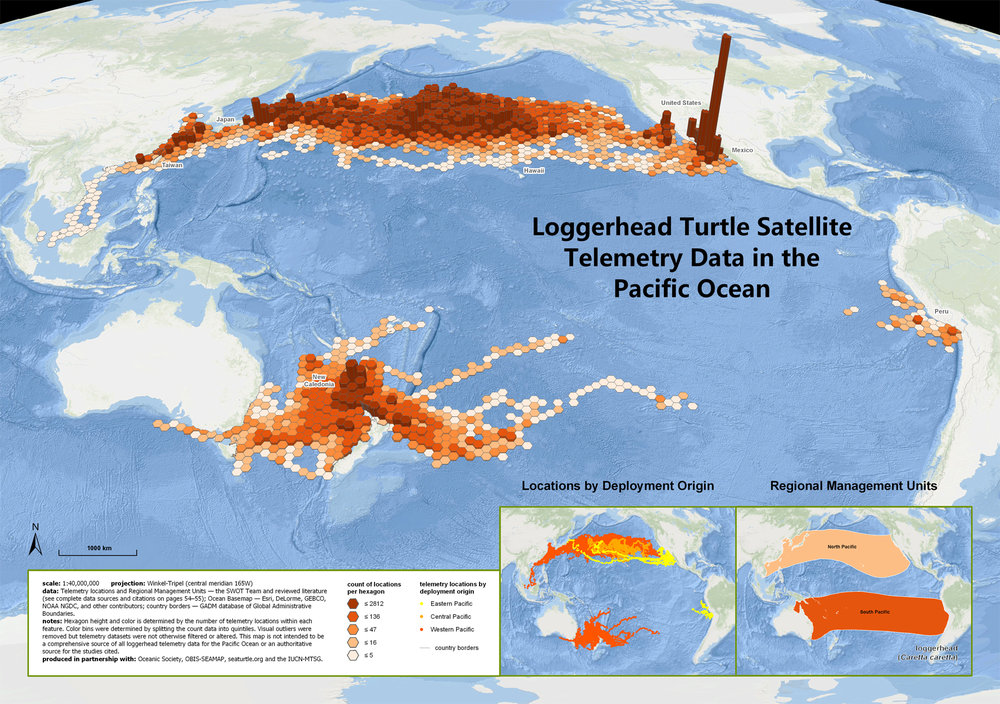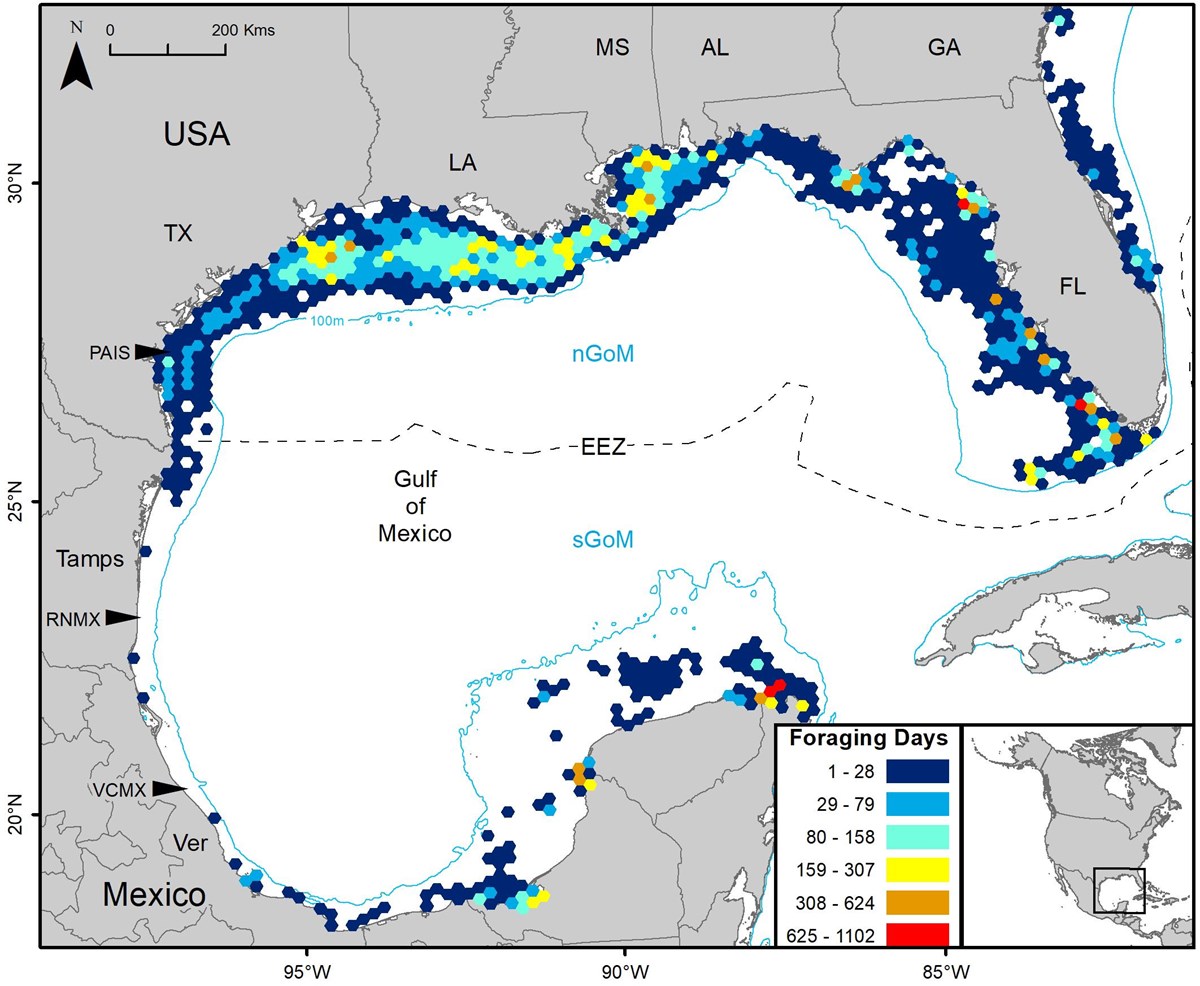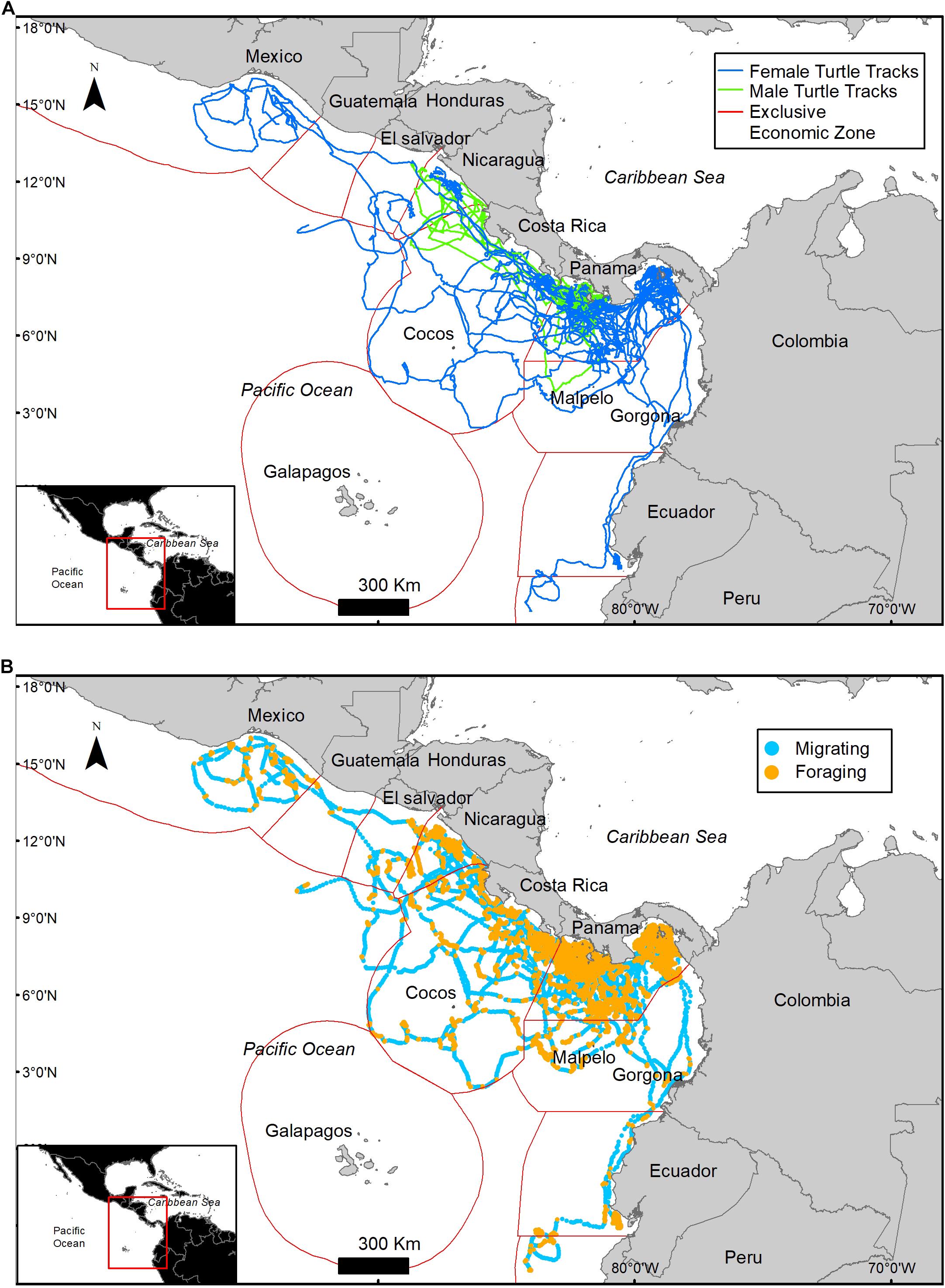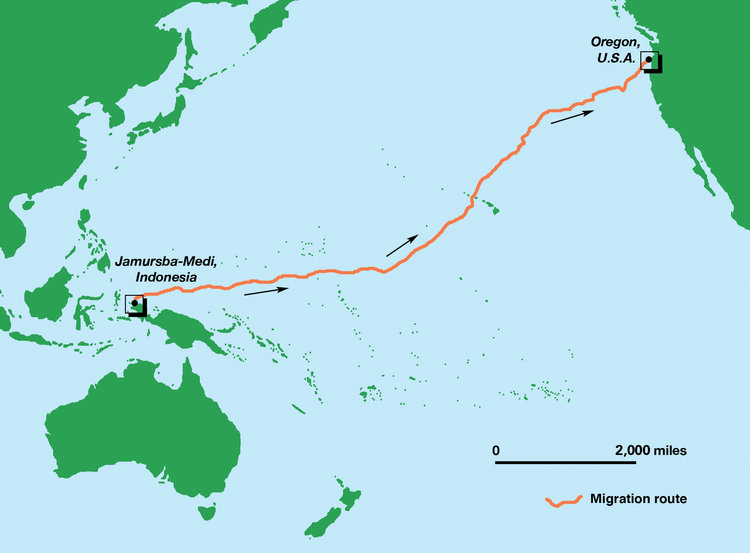Sea turtle migration is between the marine turtles’ nesting habitats and their foraging habitats. These migrations are over long distances, usually thousands of miles.
Migration also includes the offshore migration of hatchings. The migration patterns of sea turtles differ from one species to another and also between the age groups.
Some species such as the leatherback have been recorded to swim about 20,000 km (12,000 miles) in 647 days. The green sea turtle is known to travel about 20 to 90 km in a day. These turtles are agile swimmers especially when young.
Only the Australian flatback is not known to migrate on a regular basis. Even with this, individuals have been recorded in Papua New Guinea’s coastal waters and the Capricorn Tropic.
However, the species is known to inhabit the coastal waters of Northern Australia.
Sea Turtle Migration Facts
Loggerhead Sea Turtle Migration

The loggerhead is arguably the most migratory of all sea turtles and one of the most migratory animals on the planet. Individuals are known to travel 12,000 to 16,000 km.
The loggerhead’s binomial name is Caretta caretta and this species is a chelonid meaning it is part of the Cheloniidae which includes all but one sea turtle – the leatherback.
C. caretta is endemic to all temperate and tropical oceans on earth. The species lives in the Atlantic from Argentina to Canada; in the Pacific from Japan to Australia and from Chile to Alaska; in the Indian Ocean from western Australia to the Arabian Gulf to southern Africa; and in the Mediterranean.
The species migrate from their natal beaches to foraging habitats around the world. They eventually return to their natal beach once they reach maturity to mate and nest. During the winter, the species also migrate to subtropical and tropical habitats.
In the North Pacific, the loggerhead is known to migrate from Indonesia & Malaysia in southeast Asia to California and Alaska; and from Japan to North America. In the south Pacific, the species is known to migrate from Australia to South America.
The transoceanic migration from Japan to North America stretches 12,000 km. These populations are known to nest in Japan and forage in the eastern North Pacific as adults.
Hatchlings and juveniles can be found in the central North Pacific right after leaving their nest in japan. According to research conducted by Stanford Woods Institute for the Environment, as many as 43,000 loggerheads reach Baja California in Mexico and live in the oceans here for up to 20 years until they reach maturity. The turtles return to their natal beach in Japan to mate and nest.
In the Atlantic, loggerheads travel from Canada and the East Coast to the Caribbean. In 2019, Yoshi, a loggerhead was recorded to have traveled 34,000 km after 730 days.
You can see the tracked Loggerheads at this link here.
Green Turtle Migration

Similar to other sea turtles, the green turtle migrates between their foraging habits and their nesting habitats.
These species migrate every 2 to 5 years. As you may imagine, their migration is determined by the frequency at which they mate.
The binomial name of the green turtle is Chelonia mydas. The species belongs to the Family Cheloniidae which includes all sea turtles apart from the leatherback.
As with other turtles, the species migrate from their foraging habitats to the nesting beaches where they hatched. While males remain in the waters near the coasts, females must venture to the beaches to nest.
The species can travel 20 to 90 km every day and may be seen traveling in large groups. They swim at speeds of 1.6 to 1.9 miles per hour or 2.5 to 3 km per hour.
Entire generations will migrate between their natal beaches and their foraging habitats. They are distributed all over the world and can be found in both subtropical and tropical oceans.
Check out some Green Sea Turtle migration tracking here.
Kemp’s Ridley Migration

This species has two main migratory routes and these are found in the Gulf of Mexico and from Bermuda to the Mississippi coastline and to Newfoundland. You can say that the species is endemic to the Gulf of Mexico and from Canada (Newfoundland and Nova Scotia) to Bermuda.
The binomial name of the Kemp’s Ridley is Lepidochelys kempii. This is one of two species of the genus Lepidochelys.
In the Gulf of Mexico, they are found from Florida all the way to the Yucatan peninsula. The turtle migrates across the shores of the Gulf of Mexico according to Science Direct. Stops along the way include Tecolutla (in Mexico), Rancho Nuevo, Padre Island National Seashore (in Texas), and Gulf Shores (in Arizona, US).
Within the Gulf of Mexico, migration from nesting beaches to foraging habitats occurs from late May to August and peaks in June. Unlike other turtles such as the loggerhead, the kemp’s ridley’s migration is short.
The migratory corridor of the Gulf of Mexico has a depth of 26 m and is 20 km from the shore. Once the turtle hatchlings, the Kemp’s ridley heads to sea and drifts until it reaches a length of around 8 inches.
This can take about a year to two years. Once the species reaches this length, they migrate to either the northwestern Atlantic Ocean to the shores of the Gulf of Mexico.
Mature individuals may migrate from nesting habitats located in Mexico and Texas to foraging sites and return to nesting habitats. Not all males migrate every year.
They may just stay in their foraging sites and mate with females en route to the natal beaches.
Learn more about how we track Kemp’s Ridley Sea Turtles and their migration.
Olive Ridley Migration

Unlike the kemp’s ridley, the olive ridley is known to have long complex migration routes that have no apparent migratory corridors. The routes of this species’ migration seem to change each year.
The species can be found in many habitats. The first stage of migration for this species occurs the moment they hatch.
The neonates start by floating passively in the major currents close to their natal beaches. While floating passively, these hatchlings may share a habitat with mature individuals.
The binomial name of the olive ridley is Lepidochelys olivacea. The olive ridley and Kemp’s ridley are part of the genus Lepidochelys.
These turtles mirage from their foraging habitats to nesting habitats and beaches. As already mentioned there seem to be no migratory corridors. The species can travel hundreds to thousands of kilometers to mate.
Some significant nesting habitats and beaches of the species include Gahirmatha in Odisha in the Indian Ocean and along the coasts of Costa Rica and Mexico.
The arribadas of the olive ridley occur in the eastern pacific ocean of Mexico (such as in the Ixtapilla in Michoacan, Morro Ayuda & Playa Escobilla in Oaxaca) and in Central America such as at the Ostional beach and Nancite in costa Rica.
In La Flor and Chacocente in Nicaragua, arribadas are relatively common. The arribada also occurs in Panama, specifically in Isla Cañas and the Southern Zone of Veragua.
The foraging grounds from which they migrate occur all over the world with major forging grounds located in Southern California and Baja California.
Click here to read and learn more about Olive Ridley migration.
Hawksbill Migration
Similar to other sea turtles, these tires are highly migratory and move between their natal beaches and their foraging habitats.
There are individuals that decide to leave near their natal beaches. The species is known to travel hundreds to thousands of kilometers between their foraging habitats and the beaches where they hatch.
The species is known as Eretmochelys imbricata. This is the species’ binomial name. This turtle is part of the Family Cheloniidae. The species is endemic to the tropical and subtropical oceans of the world.
Similar to green turtles, adult hawksbills migrate between their foraging habitats and their natal beaches once every several years. The Solomon Islands hawksbills migrate between Australia and Arnavon Islands. This is a distance of 2014 miles (3242 km).
They nest in Arnavon (in the Solomon Islands) and forage off the coast of Australia. Hawaiian hawksbills stay within Hawaii, migrating within the island chain.
A female that nests in Buck Island Reef National Monument in the U.S. Virgin Islands was recorded to have traveled over 1000 miles to Miskito Cays in Nicaragua where it forages.
Juveniles are also known to migrate upon birth. Juveniles are known to migrate to developmental habitats which can be thousands of kilometers away from their natal beaches.
Read more about this Hawksbill Satellite-tracking Case Study here.
Leatherback Migration

The leatherback, also known as the leathery turtle, the luth, or the lute turtle, is the largest turtle and one of the largest reptiles on earth. This species can reach weights of 1,100 lb (500 kg).
This huge turtle is known to live in temperate waters as well as subtropical waters. It is even known to live in subarctic waters.
The binomial name of the leatherback is Dermochelys coriacea. The species make up the Family Dermochelyidae. They are the sole species within this family.
Similar to other sea turtles, the leatherback travels between nesting grounds and foraging grounds. They nest in the tropics but feed in the temperates. The temperate oceans are abundant with jellyfish which the species feed on.
They undertake this journey when it is time to mate and nest. Juveniles including hatchlings also travel long distances from their natal beaches.
The species can migrate over thousands of miles. For instance, the leatherbacks that hatch in the natal beaches of Indonesia have been recorded to travel 9700 km or 6000 miles to California and even Oregon to feed. Other pacific leatherbacks nest in Papua and the Solomon Islands.
A leatherback tracked for 647 days traveled 20,000 km or 12,000 miles within that time period.
Read about a Pacific Leatherback Setting Long-Distance Record here.
Infographic

Frequently Asked Questions
How are young turtles and hatchlings able to migrate thousands of miles?
Adults aren’t the only ones that migrate; even two-inch-long hatchlings are able to migrate over very long distances.
For instance, the moment loggerhead hatchlings emerge from their eggs on the beaches of Florida, they migrate across the entire North Atlantic basin. This journey is thousands of kilometers long.
How do these hatchlings undertake a transoceanic journey?
Recent information shows that these turtles swim only when needed and passively drift ocean currents that carry them to their desired destination. The only time these turtles swim is when the ocean currents carry them off course.
These younglings passively drift in currents that move in the same direction as the hatchlings’ destination. This allows the turtle to travel long distances while preserving energy.
According to research carried out by a marine biologist, Kenneth J. Lohmann, at the University of North Carolina, the hatchlings use smart swimming to optimize energy use.
Why do sea turtles migrate?
There are a few reasons why sea turtles migrate.
Juveniles and hatchlings migrate to avoid predators. These young individuals travel to the relative safety of the open sea where they can forage and grow with fewer predators around. These turtles migrate very slowly. Regardless of this, very few hatchlings are able to make it to adulthood. It is estimated that only one out of four thousand hatchlings from Florida makes it to maturity.
Matured sea turtles migrate for different reasons. Because the foraging habitats of the turtle species may be a long way from their nesting habitats, the turtles have to travel between the nesting and foraging habitats yearly to biennially.
Turtles also migrate from temperate habitats to subtropical and tropical habitats during the winter.
What is the effect of sea turtle migration?
There are different effects of sea turtle migration. For hatchlings and juveniles, migration reduces the length of time for which they are vulnerable to predators. The predators include birds of prey, rodents, foxes, dogs, cats, and many other animals that target the hatchling in shallow waters of the beach as well as on the beach.
With adults, migration allows the turtle to return to suitable nesting beaches.
How long do sea turtles migrate?
So how far do sea turtles travel? Most sea turtles are capable of traveling several hundred to thousands of kilometers. Some such as the north pacific loggerhead can travel as much as 16,000 km. The longest recorded migration of a green sea turtle is 3,979 km from Chagos to Somalia.
Do sea turtles migrate in groups?
Sea turtles do not normally migrate in groups although some are known to arrive at nesting grounds together. Sea turtles are also known to congregate offshore. Species that are known to arrive at nesting grounds in large numbers are the ridleys including kemp’s ridley and olive ridley. This arrival is known as the arribada which means arrival in Spanish.
How far do green sea turtles migrate?
Green sea turtles, also known as green turtles, travel thousands of kilometers when they migrate. Some green turtle populations travel as much as 1,300 miles or 2,094 km across the Atlantic from the coasts of Brazil where they forage to Ascension Island where they nest.
Conclusion
Sea turtles are known to migrate between their foraging habitats and their nesting habitats. These turtles can migrate over extremely long distances. For instance, wild leatherback turtles have been known to cover a distance of 20,000 km in 647 days and green sea turtles have been known to cover 20 to 90 km daily.
All marine turtle species are known to travel long distances regularly. The only species that isn’t known to migrate regularly is the Australian flatback which is endemic to the Australian continental shelf. Even with this species, individuals have been found as far north as Papua New Guinea, over a thousand miles from their usual habitats.

